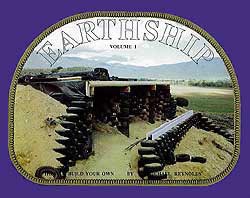
Earthship Volume I
How to Build Your Own
by Michael Reynolds
Imagine living in a home that costs nothing to heat or cool. Imagine building this home yourself. Imagine growing your own vegetables year round in this home. Imagine having no utility bills. Imagine having easily available and unlimited resources to build this type of home. Imagine your own earthship!
An Earthship is a structure that is self-sufficient. It is a building that provides it's own heat, cooling, water, electricity and sewage treatment. In addition it is built with reused or otherwise environmentally sensitive materials, that are relatively cheap, readily available, and easy to use. Used automobile tires meet all of these criteria and make the basic building block for an Earthship. Author Michael Reynolds describes earthships, the theories behind them, and why they work. Then he dives into the details of how to actually build one.
- Chapter 1 The Determining Factors of the Earthship Concept: This chapter elaborates on and develops the "independent vessel" concept as a necessary spark toward the evolution of habitat on this planet.
- Chapter 2 Interfacing with local phenomena In the Northern Hemisphere, moss grows on the north side of trees and snow melts on the south side of mountains. If you want a log to float downstream, you must place it in the current, not near the shore in an eddy. Earthships must also be placed for optimum interaction with natural phenomena. This chapter explores the natural phenomena of the planet and explains how to interface an Earthship into the existing phenomena of the area.
- Chapter 3 Following the directives of concept and natural phenomena Fast cars are designed in wind tunnels, i.e. the wind dictates the design of the car. Likewise, natural phenomena dictate the design of an Earthship. The design schematic of existing Earthships is presented in this chapter as it relates to local phenomena. Within these parameters, personal needs and desires are dealt with. The issue of performance versus tradition is discussed from the perspective of "Live simply so that others may simply live."
- Chapter 4 The Skeleton of the vessel Economy and availability to nonprofessional builders are important determinants of an Earthship structure. This chapter presents the simple structural integrity of existing prototype Earthships via conceptual diagrams, photographs and three dimensional drawings. This structural system is both designed and explained in terms to which the nonprofessional builder can relate.
- Chapter 5 The Primary building blocks of the vessel The nature of the materials used to execute an Earthship design is explored. The earth-rammed automobile tire is presented as the most appropriate method for its strength, economy, lack of skill needed, and the fact that it makes use of an otherwise discarded "natural resource." The aluminum beverage can used as a masonry unit for filler walls is also presented for similar reasons.
- Chapter 6 The details and skills used to build the "U" module The fundamentals of how to build your own Earthship are presented here. A well illustrated and explained collection of easy to learn skills, available to all types of people of various strengths, shapes and sizes is presented. This includes how to lay the rammed earth tires, how to lay the aluminum cans in mortar, connections, mistakes commonly made, etc...
- Chapter 7 How to build the greenhouse-hallway-heating duct The greenhouse-hallway-heating duct is mostly carpentry work involving relatively common carpentry skills to build the window framework on top of a tire foundation. This chapter takes you step by step through the construction and detailing of this part of the "U module.
- Chapter 8 Assimilation of Modules & Details Now that you know how to build a "U" module and how to add the greenhouse hallway on it, you are ready to learn the details necessary to assemble more than one "U". This information, together with a few miscellaneous structural and mechanical details, will provide enough information for you to be able to build your own "Earthship."
- Chapter 9 The formulas and techniques for various finishes The finishing techniques involve some do-it-yourself methods and some professional plasterer methods. The do-it-yourselfer methods are presented step-by-step with referrals to professional plaster contractors when applicable.
- Chapter 10 How to Operate Your Earthship Owner's Manual Given that Earthships are a new concept in living techniques as well as construction, some specialized knowledge regarding operations and maintenance of an Earthship is required. This chapter will help you derive the most comfort and performance from your Earthship.
- Chapter 11 The Prototypes This chapter features photographs of existing Earthships (finished and during construction), plus plans for some of them. Construction costs range from $20 per square foot to $90 per square foot and sizes range from 600 square feet to 10,000 square feet to an 80 unit destination lodge. A wide spectrum of earthship concepts are illustrated here.
Solar Survival Press. 1990. 229 Pages.
-Please scroll down the page for the "Add to Order" button.-